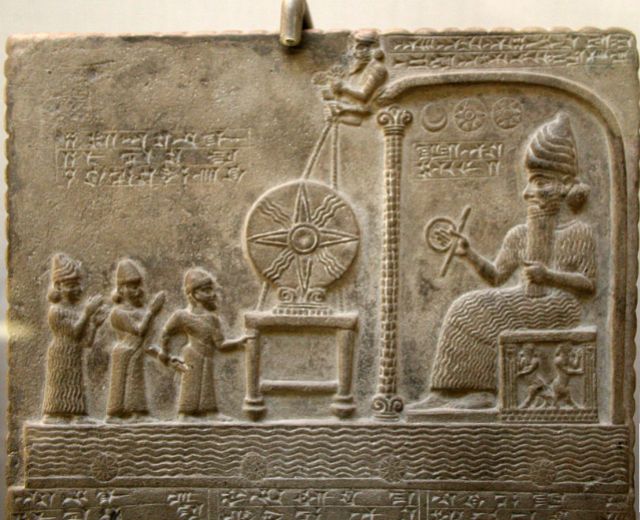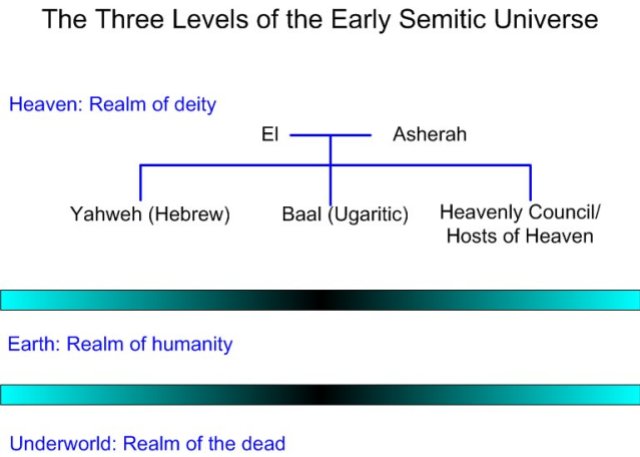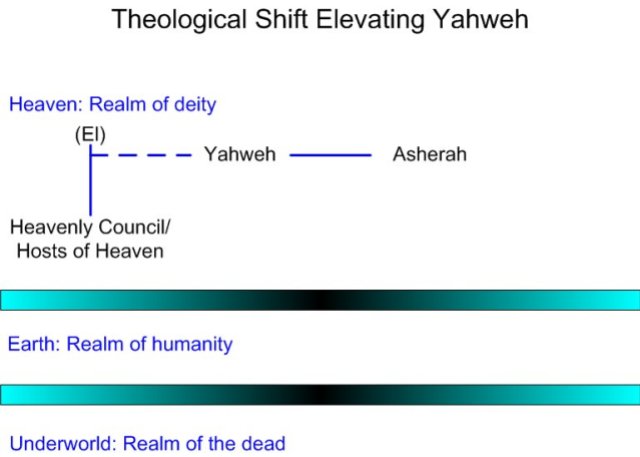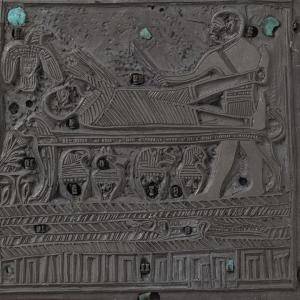The god Zedek in the Ancient Near East
The West Semitic deity Zedek, ‘Righteousness’, is found in the Old and New Testament in the personal names Melchizedek (Genesis 14:18; Hebrews 5:6; 6:20-7:17) and Adonizedek (Joshua 10:1), both Canaanite kings of pre-Israelite Jerusalem. The term “zedek” is found throughout the various writings of the Old Testament. What is an ancient pagan god of the Near East doing in the Bible? Why is he in here?
Over time, the Semitic deity Zedek became an attribute of the God of the Israelites, and a root of one of the names of the heroes of the Old Testament, Melchizedek, for which the Melchizedek priesthood is named after. In short, the writers, prophets, and poets that assembled the record of the Old Testament recontextualized the gods of their neighbors to teach truth about God as they understood him. Sometimes the qualities or characteristics of other gods of Israel’s neighbors became repackaged into actual attributes of their God Yahweh. At times these neighboring gods became synomyms for Yahweh, and at other times these gods were used to describe God, his power, or some other way of understanding God according to the manner of their speaking.
The pagan god Zedek may be related with the Amorite deity known as Isar, or the Babylonian deity Kittu, and thus a hypostasis or underlying substance, or the personification of the sun god Shamash’s function as the divine overseer of justice. Evidence for this deity in the biblical text is persuasive, and perhaps the most conclusive is a statement by Philo of Byblos (64-141 CE) that the Phoenicians had a god named Sydyk, i.e. Zedek. Philo, who claimed to get his information from the Phoenician writer Sanchuniaton, noted that the Phoenicians numbered among their gods “Misor and Sydyk, that is, ‘Easy to loosen’ and ‘Righteous’ (Misor kai Sydyk, toutestin eulyton kai dikaion); they invented the use of salt.” (Quoted by Eusebius, Praeparatio Evangelica i.10.13; instead of Sydyk, some manuscripts have Sydek or Sedek.) 1
The name of the god Zedek is not attested directly elsewhere in the biblical text, but indirect evidence is found from other sources, specifically the Amorite and Babylonian pantheons, and in the names of West Semitic peoples. Deuteronomy 16:18 gives the command to appoint judges to execute mishpat tzedek, righteous judgment. The verb צדק (sadeq) means to be just or righteous, which is a term that comes from the Phoenician god Zedek. The verb zedek happens to be in several locations in the Old Testament. It is used in the sense of having a just cause (Job 9:15), being justified (Job 11:2, Isaiah 43:9), or being just in general (Psalm 51:4, Job 10:15). Sadeq is used in a statutory or legislative sense (2 Samuel 15:4), an act of speech where judgment is issued (Deuteronomy 25:1), a punitive sense (Isaiah 50:8) and redemptive function as well (Daniel 12:3, Genesis 44:16).
Who was Zedek? In what other ways was he known?

The West Semitic god Zedek apparently corresponds to the deity known as Kittu in the Babylonian pantheon and as Isar in the Amorite pantheon. In Mesopotamia the preservation of truth and justice was considered to be the particular domain of the sun god Shamash. Truth or Right was personified and deified as the god Kittu (‘Truth’, ‘Right’; from the Akkadian root kanu. Kittu was often invoked together with the god Misharu (‘Justice’). One or both of these deities was described as ‘seated before Shamash’, i.e. Shamash’s attendant, or as ‘the minister of (Shamash’s) right hand.’ Depictions of Shamash show him holding a ring of coiled rope and a rod, objects ascribed to surveyors and therefore, when linked to rulership, denoting the act of setting things right. The Akkadian words kittu and misharu, translated into English as “truth,” “equity,” or “justice,” describe the “straightening out” of a situation whose equilibrium, put out of balance, had become “crooked.” 2
From the pairing and interchangeability of the names Kittu, Isar, and Sidqu/Zedek in the pairing with Misaru, it appears that the deity known as Kittu in Babylonia was known further to the West under the names Isar and Sidqu/Zedek – all three names having essentially the same meaning but operative in different linguistic communities. This is something that the writers of the texts of the Bible did, they recontextualized or repackaged the gods of their surrounding nations and made these gods into either attributes of their deity Yahweh, or they literally made these gods into Yahweh! These other gods became part of their belief system, in the sense that they became attributes of God or other names for their god. This is also something we see the neighbors of the Israelites doing, repackaging gods to fit within their belief systems (like Zedek/Kittu/Isar).
We see this happening in other instances of the Old Testament, for example, when we read of Resheph in the text of Habakuk chapter 3. This recontextualization occurs in many places, once we are trained to understand how the Israelites understood God and reused motifs, names, and attributes of other gods of cultures around them. These Israelite prophets, poets, and scribes would take these other pagan gods and then repackage them into attributes of their deity, or even use the name of the pagan god to describe who they worshipped. An excellent example of this is the Canaanite father god called El in the Old Testament.
We see El become part of the religion of Israel over time
In Isaiah 9:6 we read the following:
For unto us a child is born, unto us a son is given: and the government shall be upon his shoulder: and his name shall be called Wonderful, Counsellor, the Mighty God, The everlasting Father, the Prince of Peace.

In this verse, Isaiah (as many other prophets do in similar Old Testament texts) refers to God as “El” in Isaiah 9:6 as “the mighty God.” אֵל גִּבֹּור This name is very old. “El” is a god of the Ancient Near East that was written about long before the time of Moses. El is a deity in many Canaanite and Ugaritic sources that played the role of the father of a council of gods in the creation narratives of the Ancient Near East. 3 This can be a complicated topic with much to unpack, but suffice it to say that El is probably the original god associated with the Exodus from Egypt in the original texts. Later the Exodus will be associated with Yahweh when the two gods (El and Yahweh) and their identities were combined, fused into one by later editors of the text. Numbers 23:22 and 24:8 associate the Exodus not with Yahweh but with El, the poem in Numbers 23-24 (an Elohist text) contain the name of Yahweh (Numbers 23:9, 21; 24:6), but it is considerably rarer than the name of El (Numbers 23:8, 19, 22, 23; 24:4, 8, 16, 23). Indeed, El is attested almost three times as often as Yahweh in this narrative. 4
Indeed, from the text of the Old Testament that we now have, it is evident that the patriarchs worshipped El, as the name of Yahweh was unknown to them. 5 Modern understanding of the god El comes to us from a quantity of tablets discovered in 1929 in the ancient city of Ugarit, a major city-state of the second millennium BC located on the northern coast of Syria. 6 The Ugaritic tablets are the best available witness to Canaanite religion and religious practices, and thus also “to the background from which the religion of Israel emerged, and to the Canaanite beliefs that it shared, adopted, compromised with, and sometimes rejected.” 7 The Ugaritic literature depicts El as the supreme and dominant deity of the Canaanite pantheon. He is frequently referred to as “Father of the gods,” “the eternal King,” and “Creator of all living beings.” El’s other monikers include: “El the Kind, the Compassionate,” “the Bull,” “the Ageless One,” and “the Father of Years.” He is depicted as bearded, and residing in a tent or a tabernacle, whose throne rests on Cherubim. He is the god of blessings and of covenants. 8 El is a perfect representation of what Latter-day Saints would call Heavenly Father.

As Israelite understanding and belief in God developed over time, and as it moved towards a more monotheistic faith system, Yahweh went from being one of the preeminent sons of El to becoming more prominent in their belief system. El, or the Father, receded into the background, and Yahweh became the God of the House of Israel. It is likely that this process of the elevation of Yahweh was in effect by 700 B.C. and that Yahweh had taken the place of El on the council of the gods at this point in the ancient world, with all that this implies. 9
What does all of this mean and why does it matter?
A simple way to understand and package this information is to know that the religion and understanding of the God of the writers of the Old Testament was complex, and it developed over time. It is vital for us to know this so that we can read the Old Testament for what it is, an ancient text that reflected the culture, beliefs, and the understanding of people that lived long ago. Their understanding of God grew over time, and was influenced by the culture they interacted with. These poets, prophets, and scribes repackaged ideas, motifs, and gods of those around them to convey ideas that were relevant to them as it related to their understanding of God. We shall see this as we examine the 3 facsimiles in the Book of Abraham translated by the prophet Joseph Smith. While some critics claim that Joseph mistranslated these facsimiles, understanding how Jews anciently repackaged the gods of their environment to teach religious truths as they understood them will help us to understand and see how many of these symbols, gods, and images could be repackaged by the Prophet Joseph Smith to teach the Plan of Salvation, the destiny of man, and a further understanding of divinization and God’s goal for his children as we grow spiritually to become more like him through the grace of the Lord Jesus Christ. 10
 This information matters because we will see that Joseph did things with the symbols, gods, and messages of the facsimiles in the Book of Abraham that the authors of the Old and New Testaments did with texts at their disposal. Whether we are talking about the book of Matthew in the New Testament, or Malachi in the Old Testament, these authors recontextualized ideas and symbols to suit their purposes. They used the pagan gods, symbols, and motifs of their day, as well as ancient scripture to teach higher truth and to bring souls to Christ. Joseph Smith did exactly what ancient prophets did, and the more we can see them doing this in the texts, the more it strengthens my faith in his prophetic role as a seer, and the more I can actually understand the texts of sacred scripture.
This information matters because we will see that Joseph did things with the symbols, gods, and messages of the facsimiles in the Book of Abraham that the authors of the Old and New Testaments did with texts at their disposal. Whether we are talking about the book of Matthew in the New Testament, or Malachi in the Old Testament, these authors recontextualized ideas and symbols to suit their purposes. They used the pagan gods, symbols, and motifs of their day, as well as ancient scripture to teach higher truth and to bring souls to Christ. Joseph Smith did exactly what ancient prophets did, and the more we can see them doing this in the texts, the more it strengthens my faith in his prophetic role as a seer, and the more I can actually understand the texts of sacred scripture.
Notes
- James Barr, Philo of Byblos and His Phoenician History, An expansion of a lecture delivered in the John Rylands University Library of Manchester on February 13, 1974, p. 25. See also: B.F. Batto, “Zedeq,” ed. Karel van der Toorn, Bob Becking, and Pieter W. van der Horst, Dictionary of Deities and Demons in the Bible (Leiden; Boston; Koln, Grand Rapids; Cambridge: Brill; Eerdmans, 1999), p. 930. I also find it interesting that Zedek is associated with Jupiter in a number of places. In the Talmud, Zedek refers to Jupiter. See: W. M. Feldman, Rabbinical Mathematics and Astronomy (New York, 1931). The planet Jupiter is called Zedek in Hebrew astronomy. See: http://www.newworldencyclopedia.org/entry/Melchizedek
- Judith Resnik and Dennis Curtis, Representing Justice, Yale University Press, p. 18. See also Felix Guirard, Larouse Encyclopedia of Mythology, translated by Addington, Richard D. Ames (New York: Propmetheus Press, 1959), p. 55-60.
- David Leeming (17 November 2005). The Oxford Companion to World Mythology. Oxford University Press, USA. p. 60. See also Mark Smith, The Early History of God, p. 30-34.
- Mark Smith, The Origins of Biblical Monotheism: Israel’s Polytheistic Background and the Ugaritic Texts, Oxford University Press, 2001, p. 146-147.
- Mark Smith, The Early History of God, Eerdmans, 2002, p. 34. Smith writes: “The priestly theological treatment of Israel’s early religious history in Exodus 6:2-3 identifies the old god El Shadday with Yahweh. In this passage Yahweh appears to Moses: “And God said to Moses, ‘I am Yahweh. I appeared to Abraham, to Isaac, and to Jacob, as El Shadday, but by my name Yahweh I did not make myself known unto them.’” This passage reflects the fact that Yahweh was unknown to the patriarchs. Rather, they worshipped the Canaanite god, El. Inscriptional texts from Deir ‘Alla, a site north of Jericho across the Jordan River, attest to the epithet shadday. In these inscriptions the shadday epithet is not applied to the great god, El. The author of Exodus 6:2-3 perhaps did not know of or make this distinction; rather, he identified Yahweh with the traditions of the great Canaanite god, El. See also Frank Moore Cross, Canaanite Myth and Hebrew Epic, p. 47.
- Translations of the Ugaritic texts can be found in: C. Gordon, Ugaritic Literature: A Comprehensive Translation of the Poetic and Prose Texts (Pontifical Biblical Institute 1949); M. Coogan, ed., and tr., Stories from Ancient Canaan (Westminster 1978). For an introduction to Ugaritic culture, language, and so forth, see: William N. Schniedewind, A Primer on Ugaritic, Cambridge University Press, 2007. See: A Primer on Ugaritic
- Michael Coogan and Mark Smith, Stories from Ancient Canaan, Westminster John Knox Press, 2012, p. 19.
- For more descriptions of El, see Pope, El in the Ugaritic Texts, Brill Archive, 1955, 34-35; and W. Herrmann, “El” Dictionary of Deities and Demons in the Bible (Leiden; Boston; Koln, Grand Rapids; Cambridge: Brill; Eerdmans, 1999), p. 274-280.
- Monotheism, Messiah, and Mormon’s Book. Fairmormon 2003 Conference. See: https://www.fairmormon.org/conference/august-2003/monotheism-messiah-and-mormons-book accessed 3.2.2018
- Frank Moore Cross, Yahweh and the God of the Patriarchs, The Harvard Theological Review, Vol. 55, No. 4, Oct. 1962, p. 225-259. Cross wrote, “A great god such as ‘El or ‘Asherah appears in local manifestations in the cult places, and gains special titles, attributes, hypostases. In the process, one cult or title may split apart and a new god emerge to take his place beside ‘El or ‘Asherah in the pantheon. On the other hand there is a basic syncretistic impulse in Near Eastern polytheism which tends to merge gods with similar traits and functions. A minor deity, worshiped by a small group of adherents, may become popular and merge with a great deity; major deities in a single culture’s pantheon may fuse; or deities holding similar positions in separate pantheons may be identified.”

No Comments
Comments are closed.